
Flat-Earth in the Ramayana
Flat-Earth in the Ramayana
BY: MAYESVARA DASA
Mar 06, 2019 — IRELAND (SUN) —
Part One
Om tat sat.
In the previous paper we discussed the flat-Earth concept in Mahabharata. The paper can be found here.
In this paper we will discuss the flat-Earth conception in the Ramayana. By the use of the term 'flat-Earth' we are specifically referring to the Bhu-mandala (Earth circle) described in the cosmological sections of the Vedic Puranas (histories). According to the Puranas, the continents and oceans of our known Earth are located in the area known as Bharata-varsha, which is described as being on the southern end of Jambudvipa. Jambudvipa is an 800,000 mile circular island, and is the first of seven cosmic-sized dvipas (islands) that expand in the form of concentric circles for over 200 million miles of the Bhu-mandala's surface. Thus Bharata-varsha is not described as a planet floating in space, but as a small part of a colossal Earth plane. We will discuss this flat-Earth concept in Ramayana over the course of three papers.
In this Part 1 of our series on flat-Earth in the Ramayana, we would like to first build some context by discussing the vanaras (the monkey army) who served Lord Rama in the battle against the great demon Ravana. In this paper we shall discuss the vanaras in relation to Vedic teachings on cosmology and reincarnation, and then contrast these teachings with modern ideas on cosmology and evolution. We shall see presently how this all relates to the question of the size and shape of the Vedic Earth. In Parts 2 and 3 we will look at specific details related to the flat-Earth geography described in Ramayana.
The Ramayana is perhaps India’s most popular and loved book, but unbeknownst to the modern reader who may simply assume that the events in Mahabharata and Ramayana took place in the land of India, the Mahabharata and Ramayana actually provide us with the location names of places that belong to what is called the Bhu-mandala (Earth circle). In contrast to the idea that the Earth is a globe floating in space, the Vedic Puranas (histories) teach that our own area of the Earth (in Bharata-varsha) is just a tiny part of this much greater Earth circle. For the last few hundred years this Vedic teaching about an Earth circle idea has been tactfully demoted by academics to the realm of mythology. However, beginning in 2015 with arguments presented by flat-Earth exponents such as Eric Dubay and others, a practical over-night, world-wide revolution in cosmological ideas has resulted in hundreds of thousands of Internet users adding their various expertise to critique the science supporting the Copernican cosmological system. This has resulted in the exposure of numerous fallacies, contradictions, and deceptions behind the supposed science and other forms of propaganda that have created the hitherto unquestioned belief in the Earth globe itself.
It is more than coincidental that this astounding Internet phenomena has occurred simultaneously with the construction of the Mayapur Temple of Vedic Planetarium (TOVP), due for opening in 2022. One can consider that this sudden and spontaneous world-wide questioning of the globe ideology is inspired by Paramatma in order to create a revolutionary change in consciousness that will better prepare people for the unveiling of the Bhu-mandala concept via the TOVP complex.
The following paper is to provide further evidence from the Vedic tradition that supports the idea of the continents of our known Earth being just a small part of a vast circular flat-Earth plane, and not a globe floating in space. I appreciate that this idea involves a paradigm shift that many people are unable or unwilling to make, but at least for those who profess faith in the Vedic teachings, may I simply request that you let the Puranas (histories) speak for themselves.
In the following three parts of this paper we will hear about the history of Rama’s huge army of vanaras that was gathered from all over this greater Earth circle. To the modern reader, the descriptions of inconceivable numbers of vanaras , as well as descriptions of strange lands that belong to the Earth and continue for hundreds of millions of miles, may sound more like something out of a fairy-tale than an actual history. But for all those who profess to believe that Rama is the Supreme Lord, and that the Ramayana is a true and accurate history of the Lord's lila (pastimes) on Earth, it behooves one to understand and accept the size and nature of the Earth as it is revealed by Vedic authorities. Certainly we have all been conditioned by various forces to belief that the Earth is a globe floating in dark space, but one should not allow that presumed belief in the Earth globe to be the cause for doubting the description of the Earth circle as it is described in the Ramayana. Surely the opposite should be the case, namely, that one’s faith in Rama and the Vedic Puranas should lead one to doubt, or at least begin to question, the hitherto sacred and inviolable belief that the Earth is indeed a globe floating in space.
At this point a member of the International Society for Krishna Consciousness may feel no reason to even question, what to speak of doubting, the absolute certain belief that the Earth is indeed a globe; but such complacency is generally due to the fact that most members of our society are not familiar with the Bhu-mandala (Earth circle) concept, and thus are naturally unable to fathom the radical implications that this Bhu-mandala concept holds for our current Earth globe paradigm.
FORBIDDEN ARCHAEOLOGY AND FORBIDDEN COSMOLOGY
In the previous paper we mentioned that the general approach by scholars of Vedic histories (Puranas) is characterized by two underlying assumptions: (1) that the Puranas are India-centric and (2) that the Earth is a globe. These two assumptions have beleaguered attempts to understand the Purana’s own revelation that our known Earth is only part of a much greater Earth circle. Let’s consider the validity of these these two assumptions:
(1) First, it is presumed that the Puranas are India-centric, meaning that the casual reader or historian simply supposes that the events mentioned in the Puranas must have happened somewhere in India, or at least somewhere in the immediate surrounding area—and certainly not as having occurred in places as far-flung as Africa, North and Western Europe or America, etc. However, anomalous artifacts such as the Garuda bell pictured below, continue to defy the current Darwinian view of history.

A Vedic Garuda bell found in a 300 million year-old coal deposit in USA
Any modern Hindu would immediately recognize the above bell as a Garuda bell used in part of the ritual that accompanies Vedic ceremonies. However, this particular bell is 300 million years old and was found not in India, but in a small town in West Virginia, USA. The discovery was made in 1944 when a ten year-old boy called Newton Richard Anderson had dropped a piece of coal, which subsequently cracked open to reveal the Garuda bell inside. The bell clearly shows Garuda in the traditional pose of two hands clasped together in prayer, and with two wings outspread. The Garuda bells are particularly used in the worship of Vishnu, and the find is evidence of an ancient practice of Vaishnavism in North America. The coal in which the bell was embedded came from a coal deposit that was dated (by analysts researching the discovery) to be 300 million years old.
The above artifact is unquestionably part of the paraphernalia used by Aryan people in their worship of Vishnu. The discovery of the bell completely contradicts the prevailing paradigm of the evolutionary historical timeline which teaches that advanced human civilizations had not appeared at that time. The current timeline states that Homo-sapiens appeared between 100,000 and 200,000 years ago, and that human civilizations capable of producing a bell (such as the one mentioned above) appeared only within the last few thousand years. A 300 million year old bell not only refutes that idea, it also refutes the idea that ancient civilizations on different continents had developed independently, and that there was little or no contact or shared culture between them. The existence of the swastika alone refutes this wholly erroneous idea that people on different continents had no contact with each other, for the swastika (symbol of the Aryan people) can be found in every ancient culture and continent of our known Earth. See, for example: Theyguideme.blogspot.

The above image shows pottery with a swastika symbol found at the Hohokam village near Phoenix Arizona. The pottery is dated to 400 AD and is on display at the Pueblo Grande Museum in Phoenix Arizona. Similar images of the swastika abound in North and South America and throughout the rest of the ancient world. As we know, humans do not create or display symbols whimsically; indeed so seriously do we take symbolism that in many countries it is still a criminal offence to display the swastika. Therefore, the fact that the swastika is found in every ancient society is proof that these societies belonged to a common world-wide culture in which the swastika was a venerated symbol. The meaning of the swastika as a symbol of auspiciousness and good fortune was common knowledge through-out the entire ancient world. What are the chances of an identical symbol conveying the same meaning arising independently and simultaneously in every ancient culture of the world?
Along with the recent revolution in cosmology, there has been a corresponding revolution in history, with many researchers providing overwhelming evidence for the existence of a highly advanced one world civilization. The reader may be interested in the archaeological evidence for this world-wide ancient culture as presented by Sylvie Ivanova at a Youtube channel called Newearth. There are many other channels in the same genre that are rapidly changing current ideas of our ancient past. In keeping with the theme of our paper, the image below shows a statue of a vanara or monkey god at the Mayan site of Copan in Honduras. Any Hindu will immediately recognize the figure of Hanuman in the traditional kneeling posture, and holding his famous club. I need hardly point out that ordinary monkeys don't kneel in prostration, nor do they wield clubs. Again, what are the chances of two supposedly independent cultures, separated by thousands of miles of ocean, developing an identical conception of a devout club-wielding monkey God?
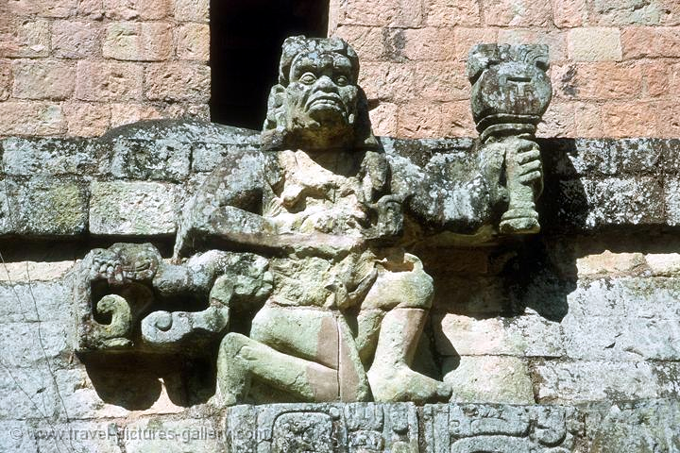
Statue of a monkey god (Hanuman) at the Mayan site of Copan in Honduras
In a lecture given in 1972, Srila Prabhupada stated that America was once part of the ancient Vedic culture, and was included as part of Bharata-varsha (a name traditionally associated with India alone). This makes sense when we consider that the measurements for Bharata-varsha given in Srimad Bhagavatam actually cover many tens of thousands of miles, and thus extend to areas beyond even our known world. The above archaeological finds, along with many others, confirm Srila Prabhupada's statement about America given in the following address:
"So Bharata-varsha means the whole planet. But we have lost...Just like we have lost portion of the present Bharata-varsha as Pakistan. Everyone knows, twenty years before there was no such thing as Pakistan. But circumstantially we have lost. So..., so the whole Bharata-varsha has been partitioned as this portion is called America, this portion is called Europe, this portion is called Asia. These are modern names. Actually, the whole planet was Bharata-varsha. And the whole planet was being controlled by Vedic culture. (Bhagavad-gita 2.1, Ahmedabad, December 6 1972)
(2) The second factor that overshadows study of Vedic cosmology is the almost unquestioned assumption that the Earth is a globe. Since almost everyone is conditioned by the modern education system that teaches the Earth is a globe in space, even if someone were to argue that the ancient Vedic culture was world-wide and not local to India, it is again assumed that the events described in the Ramayana and the other Puranas must be certainly limited to the surface area of the Earth’s supposed circumference—an area calculated as 24,900 miles. Despite reading descriptions in the Puranas of the Vedic Earth (Bhu-mandala) as measuring hundreds of millions of miles, the modern scholars (both Western and Indian) are at loss to explain these descriptions. The devotional scholars may respectfully gloss over these anomalies without understanding or appreciating their significance to the cosmological debate; meanwhile, their secular counter-parts simply reject these descriptions as being unscientific, primitive mythology born of the imaginative minds of the Vedic rishis.
In the passage below, Srila Prabhupada argues against both an India-centric and Earth-centric reading of the Puranas, stating that the Puranas are the history of civilizations throughout the entire universe, and not just of our known Earth. [Even our known Earth is just a minute part of the greater Earth circle]. Srila Prabhupada also states that the Vedic histories of great civilizations go back for millions of years, thus contradicting the Darwinian Theory regarding human evolution:
“As far as we, the followers of Vedic civilization, are concerned, we accept the Vedic history of the whole universe, which consists of different planetary systems, called Svargaloka, or the higher planetary system, Martyaloka, or the intermediary planetary system, and Patalaloka, or the lower planetary system. The modern historians of this earth cannot supply historical evidences of events that occurred before 5,000 years ago, and the anthropologists say that 40,000 years ago Homo sapiens had not appeared on this planet because evolution had not reached that point. But the Vedic histories, such as the Puranas and Mahabharata, relate human histories which extend millions and billions of years into the past.” (Preface to Krsna, The Supreme Personality of Godhead)
The initiative by His Divine Grace A.C. Bhaktivedanta Swami to present ancient Vedic cosmology to the modern world via a Temple of Vedic Planetarium is an initiative that brings with it a clash of world-views that we have not seen since the Copernican revolution, and which will undoubtedly reverberate for centuries to come. The clash of world-views arises because the Puranas describe not only an ancient Aryan empire that was ruled from India and extended to all corners of our known Earth, but also because it describes this empire extending to other parts of a much bigger Earth circle (Bhu-mandala). This flat-Earth concept obviously presents a radically different conception of Earth from our present understanding of Earth as a globe floating in space. The competing ideas between the Vedic and modern world-views will undoubtedly be a challenge not only to the wider community of the world, but also to the members of the International Society for Krishna Consciousness who have all grown-up with the full inculcation of the Earth-globe paradigm. The Vedic flat-Earth conception (Bhu-mandala) is the forbidden cosmology.
COSMOLOGY, REINCARNATION, AND DARWIN’S THEORY OF EVOLUTION
Valmiki’s Ramayana is also regarded as a Vedic history and revolves around the story of Lord Rama and His wife Sita. The Ramayana is divided into six books or kandas, and for the purpose of this paper we shall focus on location names mentioned in the Kishkindha Kanda (fourth book) of the Ramayana. This section of the book deals with the search and rescue of Sita-devi, who had been abducted by the demon Ravana. The search for Sita was conducted by a great vanara army who came to assist Rama in the attempt to recover his beloved wife.
Although commonly described as monkeys, the vanaras of Ramayana are actually a species somewhere between humans and monkeys. The name vanara (‘forest man’) derives from the word vana, meaning ‘forest’, and nara, meaning ‘man’. However, one’s amazement at seeing this particular type of man is expressed in the name Kimpurusha, which is also associated with the vanaras . The name Kimpurusha is actually a question regarding one’s puzzlement at the nature of the monkey-like human; the Sanskrit word kim raises a question and the word purusha means ‘man’. Thus Kimpurusha means: “What sort of man?” Or, “Is it a man?” The association of vanaras with Kimpurusha’s can be found in the following statement from Krishna:
kimpurushanam hanuman
I am Hanuman among the Kimpurushas (SB 11.16.29)
Hanuman, of course, is the greatly popular monkey-like god who served Rama in the war against the demon Ravana and his rakshasa army.
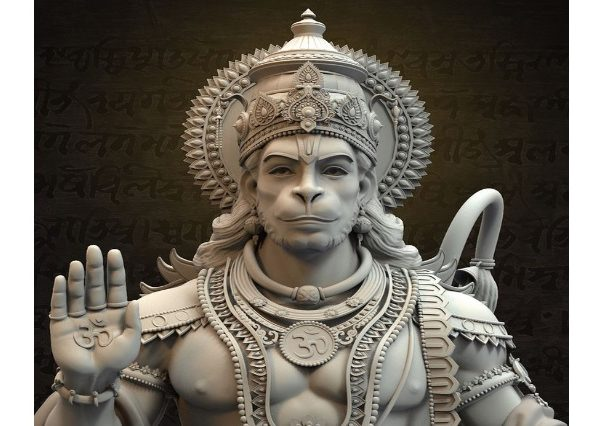
Murti of Hanuman
Although vanaras seem to be particularly associated with Kimpurusha-varsha, the Puranas also mention that Gandharvas and other types of beings also live there. It is likewise mentioned that Kimpurushas also live on other islands of the Bhu-mandala. Indeed as we shall see later in Part 2, the vanara army was gathered from all seven islands of Bhu-mandala.
We should not confuse the vanaras with the speculative assumptions of evolutionists regarding a supposed intermediary breed between monkeys and humans that has long died out. Vanaras are a highly civilized form of life, and according to Srimad Bhagavatam, Hanuman and other vanaras exist even today in this place called Kimpurusha-varsha (SB 5.19.1-2). We shall show presently the location of this area on the Bhu-mandala map along with its distance and direction from our known part of the Earth.
It is not improbable that the vanaras still live in certain areas of Bharata-varsha, or at least make an occasional appearance. Even in our modern era we have the Sasquatch and Yeti phenomena involving various testimonies of people who were shocked at encountering a half-man, half-ape type person. The Sasquatch, however, are generally portrayed as more ape than human, whereas the vanara are described as more human than ape. They also follow Vedic culture, and are endowed with mystic powers (see SB 4.18.20 and purport).
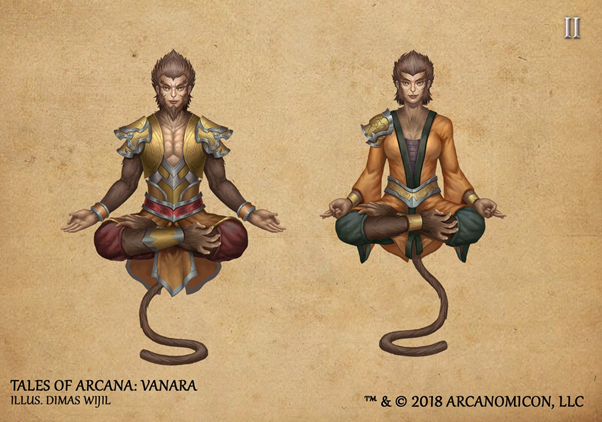
The vanaras can speak with humans, they wear clothes, they have a spiritual life, they have marriage and other cultural ceremonies, they build cities and gardens, yet at the same time they have monkey-like characteristics and features.
In our modern popular culture we have remnants of this idea in many popular novels and movies. In James Cameron’s movie called Avatar (2009), the plot revolves around a tribe of blue monkey-like humanoids known as the Na’vi who live on a planet called Pandora—a lush natural paradise that is under threat from a space-age mining company that wants to strip the planet of its natural resources.

Scene from Avatar movie (2009). Note the Vaishnava-like markings on the forehead.
As we shall see, this concept of a paradisaical landscape inhabited by a civilization of advanced monkey-like humans is quite similar to the Srimad Bhagavatam’s description of Kimpurusha-varsha, where the great Hanuman is said to reside (SB 5.19.1). According to Sukadeva Goswami, Kimpurusha-varsha is one of the bhaumani-svarga or ‘heavens on Earth’ (SB 5.17.11). Therefore, on account of being a heaven “on Earth”, Kimpurusha-varsha is not actually a planet floating somewhere in dark outer-space as in Cameron’s movie; rather, Kimpursusha varsha is actually a lot closer to home, being just a few thousand miles north of, but outside of our known Earth area.
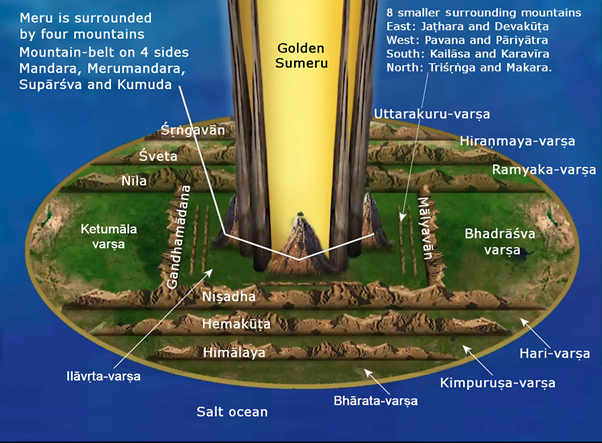
The above picture shows Jambudvipa divided into nine varshas by eight huge mountain ranges. The southern varsha is called Bharata-varsha. Our Earth is located somewhere in this region. If one were to travel from the very southern point of Bharata-varsha to the northern border, the distance would be 9,000 yojana (72,000 miles). This suggests that there is much more land and sea surrounding our known continents (which only covers approximately 12,000 miles from north to south). After 72,000 miles, one would encounter a great mountain called Himavata (Himalaya) that stretches from the west coast of Jambudvipa to the east coast for a distance of 80,000 yojana (640,000 miles). This great mountain forms the border between Bharata-varsha and Kimpurusha-varsha. All land south of this 640,000 mile mountain is Bharata-varsha—again informing us of the existence of more land to the east and west of our known continents. In the Discussion about Bhu-mandala, (July 3, 1977, Vrindavana), Srila Prabhupada stated that we can travel further east and west than presently known, but that we are restricted from further travel by the higher controlling power of deva. Like a bull tied to the stake we travel around the limited area of our continents, and think this is the limit of the Earth. The great Himalaya at the north of Bharata-varsha is 80,000 miles high and 16,000 miles wide. After crossing Himalaya one comes to Kimpurusha-varsha.
Kimpurusha-varsha includes all the land between Himalaya Mountain and the next mountain shown in the diagram (see above), called Hemakuta Mountain. The north-south distance between these two mountains is also 9,000 yojana (72,000 miles). Considering also that Himalaya is 80,000 yojana (640,000 miles long), and Hemakuta is a staggering 90,000 yojana (720,000 miles long), the total area of land between these two great border mountains is massive indeed. The image below shows the circular-shaped Jambudvipa with golden Mount Meru in the center. Crossing the surface of Jambudvipa are massive border mountains that run coast to coast and create the divisions between one varsha and another:
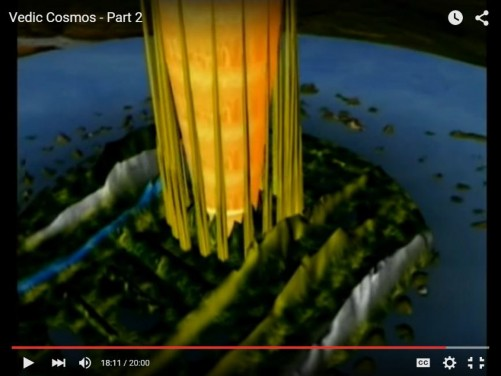
Considering the colossal size of these fantastic mountains, it is not surprising to hear the history in Ramayana of hundreds of billions of vanaras coming from these areas in order to serve in Rama's army. One may choose not to believe the descriptions of such vast numbers, but at least the figures are consistent with a bigger Earth concept. Such inordinate figures make no sense at all in the context of an Earth globe paradigm.
In order to clear any idea that Kimpurusha-varsha is a reference to land north of India such as Tibet or Nepal, we shall discuss later in part 2 of this paper some further descriptions of the land and people of Kimpurusha-varsha. We shall see that the description of the celestial conditions in these areas, as well as the massive measurements of the land areas, rule out all possibility of identifying these places with any area in our known world.
In some ways the description of the vanaras high culture also brings to mind the intelligent race of monkeys that feature in Pierre Boulle’s sci-fi novel called Planet of the Apes.
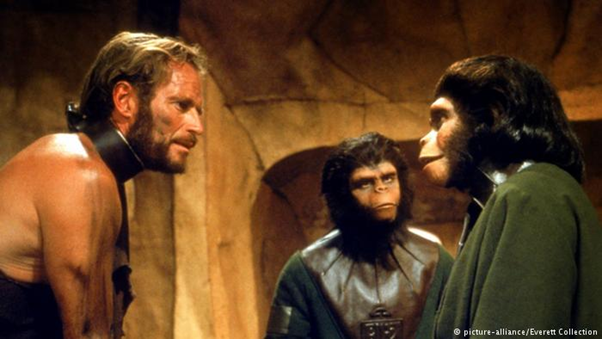
Actor Charlton Heston in Planet of the Apes (1968).
However, it must be emphasized that the vanaras in Ramayana are not aggressive or abusive to humans, as in the latter depiction. Indeed, the leading vanaras at the time of Rama were actually incarnations of the Vedic gods who appeared in that species for reasons connected to the Ramayana plot. We will not go into details of the Ramayana here, save to explain the extent and nature of the Earth as it is described in this Vedic history and how the vanaras are connected to this description. The Vedic Puranas do describe a Planet of the Apes, though it’s certainly not a planet as we understand it; indeed Kimpurusha-varsha is just a specific area on the Earth circle itself. As we have discussed above, Kimpurusha-varsha is literally the next door neighbour to our own area called Bharata-varsha.
In our modern culture we also find remnants of monkey-like humans in the character of Chewbacca of the Wookiee race as featured in the Star Wars movies.

Chewbacca
I would like to digress for a moment on this point in order to discuss the above cultural examples within the context of the Vedic teachings on reincarnation, and to further explain why these teachings are relevant to the Vedic cosmological system that describes Earth as a colossal circular plane with many other lands, seas, and kingdoms. According to the Vedic teachings, these archetypal conceptions of a human-like monkey species (such as those found in fantasy novels, movies, and art) have a basis in what the psychologist Carl Jung called ‘the collective unconsciousness’. In several verses that will follow below, Narada Muni explains that according to their karma, each living entity transmigrates through different species of life and takes birth in many different environments through-out the universe; this transmigration occurs mostly on the innumerable lands that cover the vast surface of the Earth circle (sapta-dvipa), or within the vast depths of the Earth’s core (bila-svarga and naraka). The living entity can also transmigrate to the regions of stars and higher lokas such as Mahar, Janas, Tapas, and Satya-loka, but this all depends on karma created whilst on Earth, specifically in Bharata-varsha.
The Vedic Earth is the largest feature in the universe (hence the name mahi) and the support of all beings:
yad okah sarva-bhutanam mahi
"O master of the demigods, please attempt to lift the earth (mahi), which is merged in the great water, because it is the dwelling place (okah) for all the living entities (sarva-bhutanam)" (SB 3.13.15)
The Siva Purana says:
"O great sage, therefore, along with this universe, the Earth is fifty crores of yojanas (4 billion miles) in extent inclusive of all continents and mountains. This world is the support in due course of all living beings. It has more attributes than all other elements have." (Siva Purana Uma-samhita, chapter 18, verses 76-77)
The Brahma Purana says:
"This universe extends to fifty crores of yojanas (4 billion miles) along with the Andakathaha, dvipas, oceans, and mountains. O excellent Brahmins, this Earth is the support of all worlds. It is superior to all other creations, it is noble and excellent. (BP18.99)
Again in the Brahmanda Purana chapter 18 it is stated:
"Thus this earth sustains the cosmos stationed in the universe (i.e. the whole of this universe)." (BP 18.82-84)
Again in Brahmanda Purana chapter 20:
"The Earth is the mother of all living beings. It sustains all animals and living beings. It is full of many kinds of rural regions and territories. It consists of many towns and places of shelter. It possesses many rivers, streams and mountains. It is crowded with many species of living beings. The earth, the divine goddess, is sung about as infinite and extremely extensive." (BP 20.2b 4a)
There are many such verses in the Puranas which glorify the Bhu-mandala (Earth circle) as the largest feature in the universe, as well as the support of all other living beings in the universe; thus, the Earth is in every way, the very center of the Vedic universe. So great is the stature of Bhu-devi that She along with Sri-devi are the two consorts of Lord Vishnu.
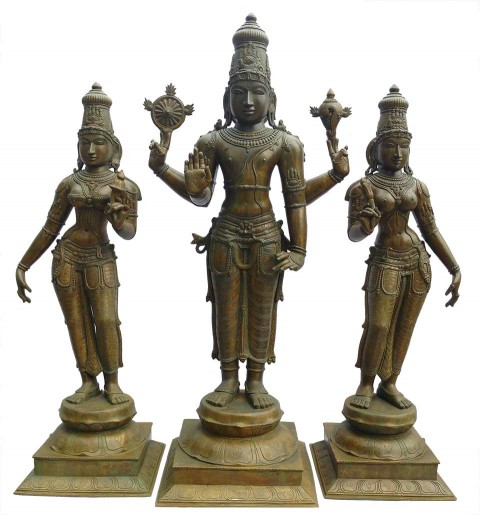
Lord Vishnu with Sri-devi and Bhu-devi
All the various species of human and animal life are found on the Bhu-mandala, though not all of them in our particular area. The modern idea that the Earth is a small insignificant globe floating in dark infinite space is nothing more than an ideology that keeps people in darkness regarding the true size, importance, and purpose of the Earth, as well the significance of one’s birth upon it.
Remembrance of previous births in all these various lokas on the Earth circle, or of births in higher lokas, is held in the subconscious mind. Thus according to the verses from the Srimad Bhagavatam below, the ‘idea’ of a human-like monkey species exists in the human imagination because we have actually experienced such a birth in a previous life; the memory is held in the collective unconsciousness, and sci-fi writers, artists, etc., draw from this collective unconsciousness and then present the idea in the form of fantastical stories, movies, and other depictions. It’s interesting, for example, that the look of the Na’vi (the blue monkey people) in James Cameron’s Avatar was inspired by a dream that Cameron’s mother had before he started work on the film. In her dream she saw a blue-skinned woman 12 feet tall. The Srimad Bhagavatam describes that the residents of Kimpurusha-varsha enjoy the conditions of Treta-yuga (SB 5.17.12); in the Treta-yuga, people, vegetation, animals etc., are all much larger than in our present age of Kali-yuga. The residents of Kimpurusha-varsha would, therefore, be much larger than our present average size.
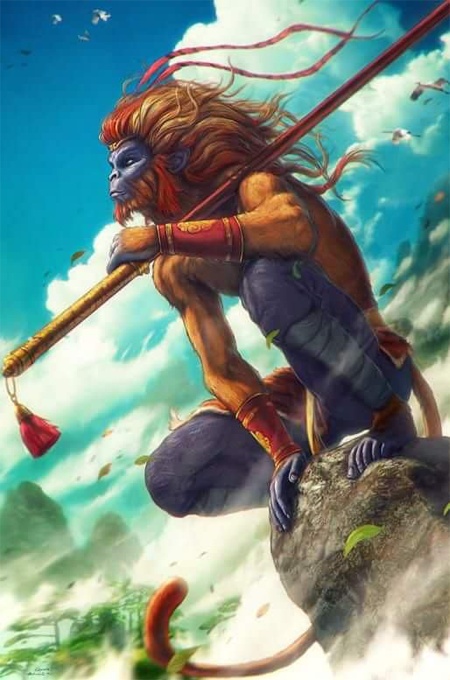
In the following verses Narada Muni describes how these images in the dreams and mind arise as a result of memories from previous lives that have been spent on Earth and elsewhere:
"Covered by the mode of ignorance in material nature, the living entity is sometimes a male, sometimes a female, sometimes a eunuch, sometimes a human being, sometimes a demigod, sometimes a bird, an animal, and so on. In this way he is wandering within the material world. His acceptance of different types of bodies is brought about by his activities under the influence of the modes of nature. (SB 4.29.29)
The living entity is exactly like a dog, who, overcome with hunger, goes from door to door for some food. According to his destiny, he sometimes receives punishment and is driven out and at other times receives a little food to eat. Similarly, the living entity, being influenced by so many desires, wanders in different species of life according to destiny. Sometimes he is high, and sometimes he is low. Sometimes he goes to the heavenly planets, sometimes to hell, sometimes to the middle planets, and so on. (SB 4.29.30-31)
After giving up this gross body, the living entity enters either an animal body or a demigod's body on this planet or on another planet. He thus enjoys the results of the actions of his past life. (SB 4.29.61)
Sometimes we suddenly experience something that was never experienced in the present body by sight or hearing. Sometimes we see such things suddenly in dreams. (SB 4.29.64)
Therefore, my dear King, the living entity, who has a subtle mental covering, develops all kinds of thoughts and images because of his previous body. Take this from me as certain. There is no possibility of concocting anything mentally without having perceived it in the previous body." (SB 4.29.65)
Although Narada Muni teaches here that "there is no possibility of concocting anything mentally without having perceived it in the previous body”, the idea of the vanara in sci-fi is generally taken to be a product of an author’s imagination, and not as a remembrance of something he or she experienced in a previous life. Likewise, the original source of knowledge for our world (the Veda), is not taken seriously as actual knowledge by mainstream academia, but is respectfully or tactfully tagged by academics as ‘mythology’. Srila Prabhupada, therefore, stressed on the point that the Puranas are not be taken as mythology, but as factual accounts of the history of the universe:
Prabhupada: ...they are all mythology. Do they not say?
Ramesvara: Yes.
Prabhupada: Therefore, I'm stressing on this point, that it is not mythology. It is fact. It is history.
(Morning Walk, June 8, 1976, Los AngelEs)
Unlike a modern sci-fi movie or novel that draws from the collective unconsciousness to create a novel, literally a ‘new’ (novella) story, the Ramayana and other Puranas are not to be considered as made-up stories like the others; rather the Puranas are to be taken as actual histories stating the facts as they actually occurred. But if the Puranic account is a fact, then why don’t we find evidence for these vanaras and other fantastic beings in the archaeological digs? The fact is that we do find tens of thousands of fascinating archaeological anomalies that remain unexplained by upholders of the current Darwinian paradigm of history and evolution.
We presented the Garuda bell at the beginning of this paper as one such anomaly. Since the release of Forbidden Archaeology by Michael Cremo (Drutakarma dasa) and Richard Thompson (Sadaputa dasa) in 1993, a virtual revolution in the understanding of world history has taken place. Thanks to the Internet we have the contribution of tens of thousands of people from around the world who daily expose the numerous fallacies, contradictions, and deceptions in the historical time-line and archaeological record. Overwhelming evidence now exists for advanced civilizations that go back for millions of years.
Srila Prabhupada was completely dismissive of the evolutionary theory:
Syamasundara: Still, you say if there were high forms of, say Brahma, in Brahma's time or millions of years ago, there were also other high animals besides men?
Prabhupada: All I say is that all kinds of different classes of forms were existing, since the creation.
Syamasundara: On this planet there were higher forms?
Prabhupada: Why are you taking this planet? We are talking of the whole creation. In the creation everything is there.
Syamasundara: If you expect me to understand this, I have to see it on this planet.
Prabhupada: That is not knowledge.
Karandhara: Possibly there were and possibly there weren't.
Syamasundara: You tell me that Rama and some other higher creatures lived on this planet so many millions of years ago, so I can expect some day to find evidence of that?
Prabhupada: The evidence is the authority, Vedic literature.
Karandhara: What other authority will you accept? If you dig up a bone and make a test with your own senses and accept that as an authority...
Prabhupada: Bone authority. So you will be satisfied with your own authority. We have got our different... If you don't accept my authority, then I don't accept your authority.
(Philosophical Discussions with Syamasundara dasa: Charles Darwin)
Srila Prabhupada’s argument against evolution can be briefly summarized as follows: The soul (life) is eternal, and is never born or dies. Thus life does not evolve, but has always existed. In the material world, a particular soul gets one type of body after another according to the desire (kama) and actions (karma) of that living entity. 8,400,000 species of life are created by Krishna, and these various bodily forms always exist to accommodate the different souls according to their desire and karma. The soul is like the driver and the various bodies are like the car. Just as the type of car we get depends on our choice and income, so the type of body we get depends on our desires and karma. Thus it is not that a lower grade car evolves into a higher grade car, but that the driver of the car (the soul) changes from a lower grade car to a higher grade or vice versa.
The car of the body is literally an illusion machine for the soul who wishes to experience maya:
"The Supreme Lord is situated in everyone's heart, O Arjuna, and is directing the wanderings of all living entities, who are seated as on a machine (yantra), made of the material energy (maya)". (Bg 18.61)
These different bodies or biological machines do not evolve as Darwin presented in his idea that the monkey form evolves through time into a human form; rather the different species of life always exist, and at the time of death, the soul within the monkey body, for example, can be promoted to a human form of life. The reverse scenario can also take place when a soul in a human form of life is demoted in the next life to the form of a monkey or some other species of life.
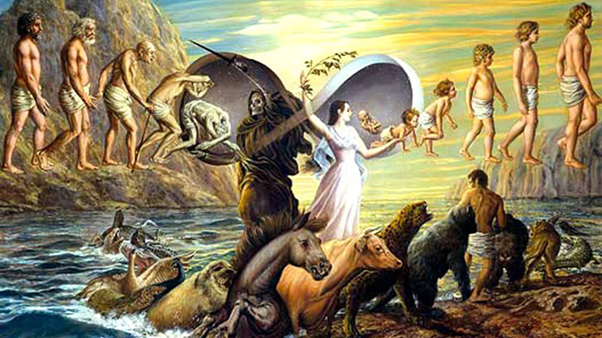
Srila Prabhupada gave the example that the body is like an apartment and the soul is like the tenant or occupier, thus just as a person can move from a less desirable apartment to more expensive and pleasing apartment, or vice versa, so the soul can transmigrate or reincarnate from an animal or other form to a human form, or vice versa as the karma dictates.
"The Personality of Godhead said: Under the supervision of the Supreme Lord and according to the result of his work, the living entity, the soul, is made to enter into the womb of a woman through the particle of male semen to assume a particular type of body." (SB 3.31.1)
karmana—by the result of work; daiva-netrena—under the supervision of the Lord
Taking the example of an apartment, it is not that the bricks and mortar of the third class apartment evolve by a random natural process into a first class apartment, rather the tenant (the soul) moves from one apartment to another. In the same way, its not that the biological form of one species evolves into another, but rather that the soul is transferred from one species of life to another according to their destiny. Srila Prabhupada explains the Vedic perspective in the following purport:
"In Srimad-Bhagavatam Lord Kapiladeva told His mother that the living entity gets a particular type of body in accordance with his work and that this body is decided upon by higher authorities. The higher authorities, as appointed by the Supreme Personality of Godhead, are Lord Brahma and all other Prajapatis and Manus. Thus from the beginning of creation it can be seen that the first creature is the most intelligent. It is not that so-called modern intelligence has developed by the gradual process of evolution. As stated in Brahma-vaivarta Purana, there is a gradual evolutionary process, but it is not the body that is evolving. All the bodily forms are already there. It is the spiritual entity, or spiritual spark within the body, that is being promoted by the laws of nature under the supervision of superior authority. We can understand from this verse that from the very beginning of creation different varieties of living entities were existing. It is not that some of them have become extinct. Everything is there; it is due to our lack of knowledge that we cannot see things in their proper perspective." (SB 4.24.73)
THERE ARE NO EXTINCT SPECIES
The idea that no species is extinct was an argument that Srila Prabhupada returned to again and again, often causing amazement, puzzlement, bewilderment, and even doubt among his disciples. Srila Prabhupada had many discussions with his disciples in which he would challenge their conventional ideas about evolution with the ultra-revolutionary Vedic concepts that would literally ‘blow their mind away’. I believe the expression to ‘blow the mind away’ is an old hippy saying which nicely expresses the soul-searching and wisdom of that era. In a society that is devoid of transcendental knowledge, our minds can become easily conditioned and attached to mental ideas regarding what is real and true; a revolutionary spiritual teacher such as Srila Prabhupada blows that mind away with the force of Vedic sound. As the wind blows away the cloud to reveal the sun, so the acharya (exemplary teacher) blows away the mental platform to reveal the truth. Since the real fact or truth can never be blown away, it is only the unreal or illusory idea that can be blown away, and in doing so reveal the truth which is always standing. Thus the guru (one who is heavy with knowledge) is never blown away, but the guru can blow away the minds of others.
In one of many ‘mind-blowing’ discussions (see conversation below), Srila Prabhupada argued that there are 8,400,000 species of life, and that they are sometimes manifest, and sometimes not manifest according to conditions; but not that any of the species ever becomes extinct. Of course, Srila Prabhupada’s disciples immediately responded by saying that archaeologists have discovered bones of ancient species that are no longer to be seen (hence extinct). Srila Prabhupada countered that they have not explored or dug all of the Earth, nor have they explored the rest of the universe, and thus their methods and conclusions are based on imperfect observation. For the purpose of his argument, Srila Prabhupada presents the Earth here as a globe with a circumference of 24,900 miles; however, the argument he presents makes even more sense when we consider the Srimad Bhagavatam’s description of the Earth as a continual plane, not as a small isolated planet of limited circumference. Srila Prabhupada did not explicitly preach about the Vedic description of a bigger Earth circle (Bhu-mandala) for reasons (we believe) as stated in our previous papers. (See here)
Despite speaking of the Earth in the conventional manner, Srila Prabhupada’s argument below that ‘the seven continents are not the whole world’, and that 8,400,000 species exist always in some part of the universe makes logical sense when we consider that the Vedic Earth is a continual plane, and that other lands of much greater size surround our own. In another conversation which we will cite below, Srila Prabhupada specifically mentions the Kimpurushas as still living. According to the Srimad Bhagavatam's description, Kimpurusha-varsha (where the vanaras are said to live) is to the north of Bharata-varsha, and beyond the boundaries of our known Earth. [Note: North, south, east, and west are also directions on a flat plane; we can think of a great city like London, for example, which is divided into north London, south London, east London, etc. The current idea of north is the north pole, but the actual north pole on the Bhu-mandala is Mount Meru. Although the magnetism of the north pole creates a mechanism for our Earth’s localized system of navigation, there are actually more areas of the Earth plane that continue in a northern direction towards Mount Meru].
Devotee: But Darwin says there are many species, like dinosaurs, that are seen to be extinct.
Srila Prabhupada: What has he seen? He is not so powerful that he can see everywhere or everything. His power to see is limited, and by that limited power he cannot conclude that one species is extinct. That is not possible. No scientist will accept that. After all, all the senses by which you gather knowledge are limited, so how can you say this is finished or that is extinct? You cannot see. You cannot search out. The earth's circumference is twenty-five thousand miles; have you searched through all the layers of rock and soil over the whole earth? Have you excavated all those places?...
…I say you have not studied all over the world. Has Darwin studied all the continents on this planet? Has he gone down into the depths of the seas and there excavated all the layers of the earth? No. So his knowledge is imperfect. This is the relative world, and here everyone speaks with relative knowledge. Therefore we should accept knowledge from a person who is not within this relativity…
…he has not seen all the species. He has not traveled all over the universe. He has seen one island, but he has not seen the whole creation. So how can he determine what species exist and don't exist? He has studied one part of this earth, but there are many millions of planets. He has not seen all of them; he has not excavated the depths of all the planets. So how can he conclude, "This is nature"? He has not seen everything, nor is it possible for any human being to see everything.
Devotee: Let's just confine ourselves to this planet.
Srila Prabhupada: No, why should we? Nature is not only on this planet.
Devotee: Because you said that on this planet there were complex forms of living beings millions and millions of years ago.
Srila Prabhupada: We are not talking about this planet, but about anywhere. You are referring to nature. Nature is not limited or confined to this planet. You cannot say that. Nature, material nature, includes millions of universes, and in each and every universe there are millions of planets. If you have studied only this planet, your knowledge is insufficient…
…You limit your study to one planet. That is not full knowledge.
Devotee: I understand and accept that. But I'm still puzzled as to why there is no geological evidence that in former times on this planet there were more complex forms.
Srila Prabhupada: Why are you taking geological evidence as final? Is it final? Science is progressing. You cannot say it is final.
Devotee: But I have excavated all parts of the world, and every time—
Srila Prabhupada: No. You have not excavated all parts of the world.
Devotee: Well, on seven continents.
Srila Prabhupada: Seven continents is not the whole world. You say you have excavated the whole world, but we say no, not even an insignificant portion. So your knowledge is limited. Dr. Frog has examined his three-foot-wide well, and now he claims to know the ocean.
Experimental knowledge is always imperfect, because one experiments with imperfect senses. Therefore, scientific knowledge must be imperfect. Our source of knowledge is different. We do not depend on experimental knowledge…
Dr. Frog has studied his three-foot well, his little reservoir of water. The Atlantic Ocean is also a reservoir of water, but there is a vast difference. Dr. Frog cannot inform us about the Atlantic Ocean. But we take knowledge from the one who has made the Atlantic Ocean. So our knowledge is perfect.
(Journey of Self-Discovery, JSD 7.4: Evolution in Fact and Fantasy)
Although Srila Prabhupada did not present his argument with reference to the Bhu-mandala concept, the enigma of Srila Prabhupada’s statement is revealed when we understand that the Vedic Earth is not a small globe of limited circumference floating in space, but rather a colossal circular disc that continues for hundreds of million of miles. In the Puranas, all manner of unusual species are describing as living on the innumerable lands both on the surface and in the depths of the huge Bhu-mandala (Earth circle). From the Vedic perspective, Srila Prabhupada is quite correct when he argues that the archaeologists have not explored the whole Earth.
Srila Prabhupada had full faith in the Vedic teachings, and in the conversation below we hear him explaining that the Kimpurushas or vanaras are still existing:
Prabhupada: We don't say it is extinct.
Tamala Krishna: But you've explained that even if not here then it must be on another planet.
Prabhupada: Yes, another. This planet, what you have seen?
Ramesvara: That's the point, what we have seen about this planet?
Prabhupada: ... Cannot be extinct, that is not possible…
Tamala Krishna: But do you think they were on this planet?
Prabhupada: No, no, may be on this planet, but it doesn't matter that it is extinct. You have not seen.
Tamala Krishna: No, that's a fact.
Ramesvara: Their idea is that at that time man was living in the form of half monkey, half man in a cave, and gradually he evolved to become more civilized.
Prabhupada: That is still there. Kinnaras. Kinnaras means it is doubtful whether he is man or monkey.
Tamala Krishna: Wow.
Prabhupada: There is a Kinnara-loka. Kimpurusha. Kinnara. They are still existing. It is not that they are finished.
(Morning Walk, July 12, 1976, New York)
Here Srila Prabhupada says that the Kimpurushas ‘are still existing…they are not finished.’
HANUMAN LIVES IN KIMPURUSHA-VARSHA
In confirmation of Srila Prabhupada’s statement that the Kimpurusha’s still exist, Srimad Bhagavatam describes that Hanuman and other vanaras still live in Kimpursha-varsha and glorify Lord Rama:
"Srila Sukadeva Gosvami said: My dear King, in Kimpurusha-varsha the great devotee Hanuman is always engaged with the inhabitants of that land in devotional service to Lord Ramacandra, the elder brother of Lakshmana and dear husband of Sitadevi.
A host of Gandharvas is always engaged in chanting the glories of Lord Ramacandra. That chanting is always extremely auspicious. Hanumanji and Arshtishena, the chief person in Kimpurusha-varsha, constantly hear those glories with complete attention. Hanuman chants the following mantras." (SB 5.19.1-2)
In the Brhat Bhagavatamrta, Srila Sanatana Goswami writes that although Hanuman is a pure soul and certainly qualified to go to the Vaikuntha world, in order to fulfill the desire of Lord Rama, Hanuman chooses to stay on the Earth (in Kimpurusha-varsha) in order to help other souls to go back home back to Godhead.
"By the Lord’s order, this Hanuman, the one true recipient of his master’s favor, still lives in this world, though unable to bear separation from the Lord." (BB 1.4.49)
>O?Commentary by Gopiparanadhana dasa:
"Since Hanuman’s life with Lord Ramacandra after the victory was so fortunate, one might ask how Hanuman could ever have left the Lord’s association. Why did he not return with Lord Rama to the eternal Ayodhya in Vaikuntha along with the other residents of the kingdom? The answer is that his Lord specifically asked him to stay behind on earth. Atmesvara means “his own Lord,” and it also means “the Lord of all atmas.” In other words, by staying in this world Hanuman gave all its inhabitants a much better chance to take to the path of pure devotional service. Lord Ramacandra ordered Hanuman to make this severe sacrifice because the Lord wanted to bestow such mercy on the conditioned souls. Living in separation from the Lord is Hanuman’s most difficult and glorious service.
He keeps himself alive by constantly hearing the glories of Lord Rama. Staying by the side of the Lord’s Deity, He is present even today with the same splendor as always. (BB 1.4.50)
Commentary: The pain of separation from Lord Ramacandra would be unbearable for Hanuman, but he has survived by staying always absorbed in the ecstasy of sravanam kirtanam. Expert singers among the Kimpurushas like Arshtishena support Hanuman by providing sweet recitations of Lord Ramacandra’s glories for him to hear. Hanuman stays in Kimpurusha-loka, near the permanently installed Deity of Lord Rama. He regularly worships that Deity in various ways, offering the same personal services he used to perform when together with his Lord.
“Although Hanuman obtained from the son of Dasaratha the boon of liberation without striving for it, he never wanted to accept liberation without the opportunity to serve. To that Hanuman I offer my obeisances.” (BB 1.4.52)
Commentary: This is another verse Prahlada quotes from scripture, from Sri Narayana-vyuha-stava, as proof of Hanuman’s greatness. Liberation became available to Hanuman without his even trying for it, but still he did not want to accept it. He wanted only service to Lord Rama, and nothing else. He thought, “Even if the cycle of birth and death is broken for me, I must continue serving my Lord!”
In the Brhat Bhagavatamrta, Srila Sanatana Goswami further relates that Prahlada Maharaja inspired Narada-Muni to visit Hanuman in Kimpurusha-varsha:
"Prahlada told Narada: Why not go to Kimpurusha-varsha, see him yourself, and be enlivened?" (BB 1.4.53)
"Sri Pariksit said: O dear mother, the sage Narada then jumped up from his seat and flew through the sky to Kimpurusha-varsha, all the while repeating, “How wonderful! How wonderful!”' (BB 1.4.54)
"There in Kimpurusha-varsha, Narada saw Hanuman absorbed in worshiping Lord Ramacandra’s lotus feet with varied items from the forest, as if serving the Lord personally as before." (BB 1.4.55)
By utilizing the power of yoga Narada Muni was able to travel to Kimpurusha-varsha.
THE WISE LAMENT NEITHER FOR THE LIVING OR THE DEAD (BHAGAVAD-GITA 2.11)
We all observe that with the turning of our own seasons, certain migrating birds and other species sometimes appear and sometimes disappear from our perception. When a species of bird flies from north to south, the people in the north don’t conclude that the birds have become extinct simply because they are out of perception. Similarly with the change in yuga cycles, or other changes in time, certain forms of life may seem to appear and others disappear; but it should not be thought that a particular species ever becomes extinct. Srila Prabhupada argued that those species that have disappeared from our perception actually remain in some other area of the creation. As we have been trying to explain, the Vedic Earth is a much larger landscape than the continents of our known Earth, and Srila Prabhupada's argument sits well with this larger Earth concept.
For those who are justifiably sickened and saddened by the needless and ruthless, greed-driven destruction of the green Earth, its pristine oceans, beautiful people, brilliant trees, sacred rivers, innocent animals, colourful birds and insects, fascinating aquatics, etc., it is heartening to know that from the Vedic perspective, no species actually ever becomes extinct, and that all forms of life continue to exist in some part of the greater Earth.
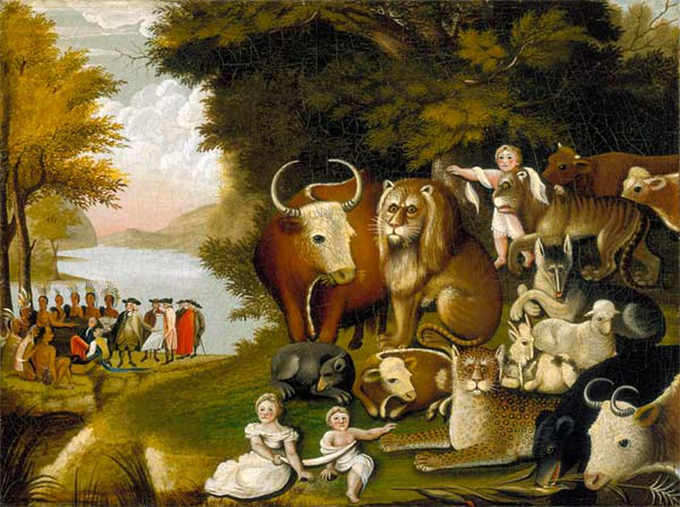
The Peaceable Kingdom by Edward Hicks
The whole material world undergoes continual cycles of creation, maintenance, and destruction, of repeated cycles of birth and death, and of repeated cycles of the four yugas—Satya, Treta, Dvapara, and Kali. The horrible violence that afflicts all creatures in Bharata-varsha is part of the course of Kali-yuga when our part of the Earth becomes overwhelmed by the tamo-guna or mode of ignorance. Within this inevitable course of time the Aryan community must try their best to set an example by maintaining dharma and sattva which will automatically lead to local areas that remain environmentally friendly, sustainable, and supportive of spiritual life. But whilst remaining friendly, sensitive, emphatic, and protective towards all life, it is also good to remember (as Krishna reminded Arjuna) that the soul of every living being is eternal, indestructible, and immutable, and that there is nothing to lament in the inevitable course of life and death. Whilst witnessing destruction all around us, we should not allow our minds to be destroyed by despair. As the asuras go about their business of destroying the world, they infuse a sense of despair and hopelessness in the face of what seems a complete loss of everything beautiful. It appears like a great nothing is consuming everything, or leaving only a terrifying uglification in its place. To the sense of despair created by this world-view it is worth repeating again Srila Prabhupada’s purport to SB 4.24.73: “We can understand from this verse that from the very beginning of creation different varieties of living entities were existing. It is not that some of them have become extinct. Everything is there; it is due to our lack of knowledge that we cannot see things in their proper perspective.” Of course individual members of a species certainly die, and even an entire species can be hunted to apparent extinction, but that is only to our limited perspective since the form of that species continues in other parts of the Earth circle.
Svarupa Damodara: Do we know that in detail, Srila Prabhupada? What type of species are extinct? Not all the species extinct. As it is during Brahma's day, that partial annihilation, devastation, now some species are extinct?
Prabhupada: No species extinct. What you are reading? This is garbage.
Svarupa Damodara: The physical forms.
Prabhupada: No, nothing is extinct. Everything is going on.
(Conversation, July 3 1976, Washington DC)
The idea that the Earth is a globe and destined to become a dead planet is hopelessly wrong and simply creates fear and despair in the mind. Our Earth is surrounded in all directions by the rest of the splendid and magnificent Earth plane. We are just quarantined from the other parts of Bhu-mandala because of Kali-yuga affecting this area of Bharata-varsha (see below). Yes, Bharata-varsha must undergo the various tribulations of the Kali-yuga, but at least for the next few thousand years the sankirtan movement will sustain (if not miraculously regenerate) the entire creation. At the end of Kali-yuga the Bharata-varsha will be completely renewed, and the various species will reappear in their splendid Satya-yuga form.
WHY CAN WE NOT SEE KIMPURUSHA-VARSHA?
In the several verses cited previously from Brhat Bhagavatamrta, we heard that Narada-muni could utilize the power of yoga in order to travel at his will to Kimpurusha-varsha. It is generally only by perfection in yoga power or by performance of the appropriate yajnas or tapas that one is able to travel to, or be born into these other areas of the Earth. There are also many descriptions of people travelling by vimana from one place to another, but this also requires qualification. However, sometimes the demons become so strong as a result of yoga power that they are able to invade these other parts of the Earth. As we have discussed in previous papers, the Earth underwent such an invasion only 5,000 years ago causing the appearance of Lord Krishna and the Pandavas who restored dharma to all parts of the Bhu-mandala.
In Kali-yuga Bharata-varsha gets quarantined from the rest of Bhu-mandala and knowledge of the greater Earth is covered over. This is for a very good reason. Since Kali-yuga only affects Bharata-varsha, the demoniac types of beings who incarnate at this time would only cause great suffering to the surrounding areas of the Earth circle. As in James Cameron’s Avatar movie where the Na’vi tribe were hunted down, their sacred sites destroyed, and their land stripped of its resources, the military industrial complex that dominates in our own world would have no hesitation in smashing its way into other areas of Jambudvipa to destroy, plunder, and violate the people and sacred places of those lands.

The above scene from James Cameron’s Avatar movie shows the destruction of the Na’vi tribe’s Hometree. Srimad Bhagavatam describes similar gigantic trees in Jambudvipa.
Fortunately for the residents of Kimpurusha-varsha they are presently protected by the superior power of deva from an invasion by the same psychopathic military industrial complex that has wreaked destruction on our own part of the Earth. They were not always so well protected. In the previous paper we mentioned the Vedic history relating to Hiranyakashipu’s conquest of the tri-loka. Srimad Bhagavatam (SB 7.8.53) includes the Kimpurushas’ as one of the various tribes through-out the universe that had been subjugated by this great asura. From the verses below, we can only imagine the extent of spiritual and environmental damage caused by Hiranyakashipu on the Bhu-mandala at that time.
"While I am engaged in the business of killing Lord Vishnu, go down to the planet earth, which is flourishing due to brahminical culture and a kshatriya government. These people engage in austerity, sacrifice, Vedic study, regulative vows, and charity. Destroy all the people thus engaged!" (SB 7.2.10)
"Immediately go wherever there is good protection for the cows and brahmanas and wherever the Vedas are studied in terms of the varnashrama principles. Set fire to those places and cut from the roots the trees there, which are the source of life." (SB 7.2.12)
"The demons set fire to the cities, villages, pasturing grounds, cowpens, gardens, agricultural fields and natural forests. They burned the hermitages of the saintly persons, the important mines that produced valuable metals, the residential quarters of the agriculturalists, the mountain villages, and the villages of the cow protectors, the cowherd men. They also burned the government capitals." (SB 7.2.14)
"Thus disturbed again and again by the unnatural occurrences caused by the followers of Hiranyakasipu, all the people had to cease the activities of Vedic culture. Not receiving the results of yajïa, the demigods also became disturbed. They left their residential quarters in the heavenly planets and, unobserved by the demons, began wandering on the planet earth to see the disasters." (SB 7.2.16)
Knowledge of the Earth circle may be treated as a joke by some, but this scoffing mentality may have less to do with the person's so-called intelligence, and more to do with the deluding influence of maya which prevents such envious Kali-yuga people from becoming a threat to others who share the rest of the Earth plane.
Due to the previous piety and karma which allows a soul to take birth in Kimpurusha-varsha (or any of the other varshas of Jambudvipa), the residents of these areas are not afflicted by Kali-yuga, and are thus kept safely away from the psychopaths who control our known world in Bharata-varsha during this period of Kali-yuga. Access to these other varshas of Jambudvipa is dependent upon the performance of yajna or yoga; not that multi-national corporations can go cutting and slashing, digging and drilling, and enslaving and killing the rest of the Earth at their whims. In the Kurma Purana it is said:
“Wise men have said that there are four yugas in the Bharata sub-continent and not anywhere else. They are Krta, Treta, Dvarapa, and Kali.” (Kurma Purana 17.45-47)
In the Devi Purana it is said:
“...but of all the varshas, continents, this Bharata-varsha is called the Karma Ksettra (or the field of actions). The other eight varsas, though on Earth, give the pleasures of the Heavens. The reason for this is that when the period of the persons’ enjoyments in the Heavens cease, they come and take their birth in the one or other of these eight varsas. The people here live for ten thousand years; their body is hard like thunderbolt and all are endowed with powers of Ayuta elephants. No one is satisfied with a little of the pleasures of sexes; so all men live happily with their wives, etc. It is not that the males alone are so happy; the females also are full of youth throughout their lives...In short, the inhabitants of the varshas enjoy for ever as the persons of Treta-yuga do." (Devi Purana 8.7.35-37)
Although Bharata-varsha is one of the nine varshas of Jambudvipa and thus part of the same landscape, it is distinct from the other varshas in that Bharata-varsha is where karma is created, whereas the other varshas of Jambudvipa are where the fruit of good karma is enjoyed.
"O great sage, in the Jambudvipa, it is the subcontinent Bharata which is most excellent since it is the land of holy rites and activities. Others are the regions of enjoyment." (Brahma Purana 17.23)
When the good karma is exhausted, the soul has to take birth again in Bharata-varsha to create further pious activity in order to return to svarga:
"Those who study the Vedas and drink the soma juice, seeking the heavenly planets, worship Me indirectly. Purified of sinful reactions, they take birth on the pious, heavenly planet of Indra, where they enjoy godly delights.
When they have thus enjoyed vast heavenly sense pleasure and the results of their pious activities are exhausted, they return to this mortal planet again. Thus those who seek sense enjoyment by adhering to the principles of the three Vedas achieve only repeated birth and death." (Bg 9.20-21)
Although Srila Prabhupada refers to Indra-loka as ‘a planet’, surendra-lokam is actually a reference to one of the eight loka-pala cities on top of Mount Meru. Mount Meru is technically part of the Earth circle and stands in the very center of Jambudvipa, rising 84,000 yojanas (672,000 miles) above the surface level of the Earth. The celestial cities of Indra and others are at the top of this Mount Meru. [Note: the root of Mount Meru penetrates a further 16,000 yojana (128,000 miles) into the depths of the Earth (See SB 5.16.7) which again tells us that the Vedic Earth is not a globe of 24,900 miles circumference].
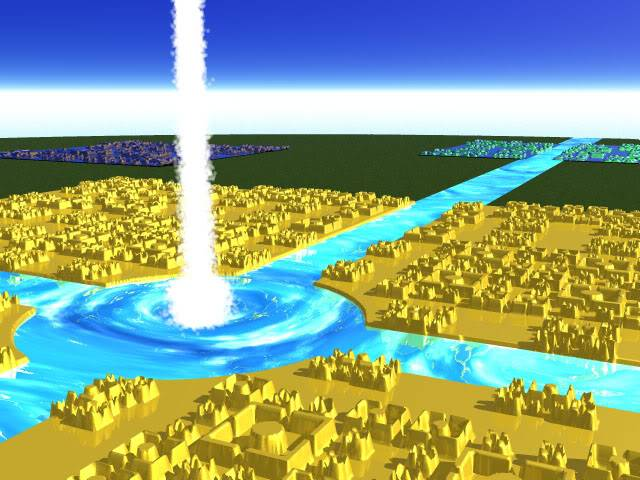
The above image shows the celestial cities of Indra and others on top of Mount Meru which stands in the center of Jambudvipa. The Ganges River falls in the center of Mount Meru and then divides into four streams. These four streams fall to the surface of the Earth in order to purify everyone in the nine varshas of Jambudvipa. The southern stream of Ganga is called Alekananda and traverses hundreds of thousands of miles across the southern varshas of Jambudvipa before eventually coming to Bharata-varsha where She appears in India.
So for all us who are materially inclined, the general procedure is to performs Vedic rituals whilst in Bharata-varsha in order to qualify for a life-time in svarga. When one’s time in life-time in svarga comes to an end, the residue of good karma is used up in one of the eight varshas of Jambudvipa that surround the base of Mount Meru:
"Among the nine varshas, the tract of land known as Bharata-varsha is understood to be the field of fruitive activities. Learned scholars and saintly persons declare the other eight varshas to be meant for very highly elevated pious persons. After returning from the heavenly planets, they enjoy the remaining results of their pious activities in these eight earthly varshas." (SB 5.17.11)
bhaumani svarga-padani—as the heavenly places on earth;
These eight varshas of Jambudvipa are known as bhaumani-svarga (heavens on earth). When’s one’s period of time is again exhausted in this bhumani-svarga, one takes another birth in Bharata-varsha in order to create new karma. Depending on the karma created during a succession of lifetimes in Bharata-varsha, one will again take birth somewhere either on one of the Earth’s seven great islands, or in one of the Earth’s vast underground realms such as the seven realms of bila-svarga (Atala, Sutala, Patala, etc), or the narakas (hell); or again, one may take birth in one of the lokas above the Earth plane, svarga, etc. One is not even guaranteed a human birth in the cycle of birth and death:
"It is from here [Bharata-varsha] that the heaven is attained; one attains absolution too from here, men attain the state of different species of animals, or fall in hell from here alone. It is from here that men go to heaven or realize absolution at the end of their series of birth. Nowhere else on the Earth are holy rites ordained for men." (Brahma Purana 17.4-5)
For those who are thoroughly exhausted and disgusted with this merry-go-round of repeated birth and death, a birth in Bharata-varsha is most welcome. Although, Bharata-varsha does not enjoy the heavenly conditions experienced in other varshas, a birth in Bharata-varsha is advantageous because it enables one to easily attain liberation from this cycle of repeated birth and death (moksha). It is also the easiest place to re-awaken one's love of God. The current atheistic cosmological and evolutionary theories form the ideological foundation for the compulsory secular education which is forced upon most of the world’s population; such indoctrination deprives people of the opportunity to hear about or develop faith in the Vedic cosmological system that explains one’s spiritual entrapment in a repeated cycle of birth and death, and ultimately how to get free of it. Srila Prabhupada conceived The Temple of Vedic Planetarium as a means to educate people through-out the world of the actual situation.
HAVE WE INVESTMENTS AND INTERESTS IN A MAYA EARTH?
Undoubtedly, the small elite who run this world are fully aware that our Earth is not a globe of limited circumference, but rather a flat-Earth plane that continues into unexplored fields. Although entrance to these areas is impossible for the current controllers of our world, it suits the purposes of our world's current leadership to maintain the illusion that the Earth is a globe. By controlling and limiting people’s perception of the Earth’s true extent, those of asuric disposition are more easily able to set themselves up as lords and masters of the supposed Earth globe.
The present scenario on Earth is similar to a prison house in which the government (devas) maintains ultimate control, but within that controlled environment, various criminal gangs (asuras) are allowed to establish their own internal prison hierarchy and control. The criminal gangs convince the other prisoners that they (not the government) are the ultimate controllers of the daily prison life. The fact remains, however, that although a particular prisoner may become the "Mr Big" in a prison and thereby lord it over his fellow prisoners, he is nonetheless restrained in many ways by the authorities, and still bound by the prison bars and walls that prevent him from going out of the prison to his destination of choice. In the same way, the present asuric leadership may have gained control over the mass of people in our present world, but they are also restrained and frustrated in many ways by the superior power of deva that prevents them from escaping the reactions and confines of their own karmic prison. In this example, the devas acting under the authority and direction of Krishna remain the ultimate controllers of the Durga prison, but the devas allow the asuras to exercise control over the other inmates according to the karma at play.
Since Krishna allows everyone their free will, the asuras are allowed to propagate atheistic theories regarding the origins and evolution of life and the universe, and by these ideological means they can convince their fellow inmates that they have no soul and that there is no God to protect them. Atheistic cosmological beliefs fool people into believing that the Earth is an insignificant globe hurdling aimlessly in a dark, empty, spiritless, infinite space. Thus a person is conditioned to believe that they have no choice but to submit or die to a materialistic system that promises them the world, but kills their soul.
To the degree that one lacks faith in Krishna, to that degree one will put their faith in this world of maya. One will thus feel a certain psychological loyalty to the ideological beliefs that uphold this particular maya world. Just as a weak prisoner out of fear of "Mr Big" will capitulate to his superior physical and ideological control (and thereby hope to find standing and protection within the criminal hierarchy), so those who lack faith in God will capitulate to the physical and ideological control of the "Mr Bigs" who run the financial and corporate sectors, the government, military, judiciary, religion, education, media, education, etc. For those who have substantial investments and interests in this maya world, the idea of anyone challenging the revered Earth globe icon is an apostasy and heresy that must be resisted at all costs—because if the Earth globe is shown to be a mere illusion, then many other cherished illusions must fall with it. The whole system is threatened. The reality of Krishna and His wonderful Bhu-mandala creation becomes too real. Thus the very 'idea' of what the Earth is and looks like will become a battlefield for the minds and souls of the present generation.
The descriptions in the Puranas of a bigger Earth plane obviously requires members of ISKCON, as well as other interested members of the Vedic community to come to a conclusion regarding this glaring discrepancy between the Vedic and modern so-called ‘scientific’ world-views. The need to resolve the issue is especially felt as the Vedic cosmology is soon to be presented to a world-wide public audience via the Temple of Vedic Planetarium due to open in Mayapur West Bengal in 2022. Indeed, as a reminder of the impending opening, I received a post this morning in my g-mail requesting a donation towards further costs of the TOVP building. And whilst I certainly appreciate the value of contributing towards the cost of such an important project, I do wonder how much the TOVP management appreciate the value of our contribution in the form of articles explaining the factual nature of Bhu-mandala, and the implications of this Bhu-mandala concept to the current Earth globe paradigm. In ISKCON we have various books, images, videos, and lectures on Vedic cosmology that accurately repeat and depict Sukadeva Goswami's description of Bharata-varsha's location in Jambudvipa; but despite hearing that Bharata-varsha is part of an 800,000 mile island called Jambudvipa, it has not quite dawned on those who present such information, or on those who receive such information, that the description of Bharata-varsha is a description of a location on a larger flat-Earth plane, not a description of a globe floating in space. Despite having books, images, videos, and lecturers that tell us Bharata-varsha is actually part of Jambudvipa, (and thus cannot be a planet floating in space), should anyone happen to point out the obvious flat-Earth deduction, then such a person is looked upon as a heretic and deviant. How dare anyone question our beloved Earth ball! But that's exactly what Sukadeva Goswami is telling us to do!
The question then is whether the presentation of Bhu-mandala in the TOVP will be true to the description in the Puranas (for all the radical implications that will have for the ISKCON'S standing in a world dominated by globe ideology); or whether the members of the society have simply too many investments and interests in that same Earth-globe ideology in order to seriously question or challenge it. If Mr Big says that Bhu-mandala is not a flat-Earth, then who will argue otherwise? Maybe its just easier to remain in a world of illusion within a world of illusion. But who will decide the final depiction and accompanying explanation of the Bhu-mandala as it will appear in the TOVP in 2022; and what will be the motives, interests, investments, agencies, etc., that combine to decide for the rest of the world what the Vedic Earth shall look like?
For those members of the Vedic community who are interested in the discussion, may I begin by pointing out that the existence of an Earth globe floating in space should not be simply assumed as the real and true one, and thus the measure by which to reject, dilute, or compromise the Vedic version; rather, the descriptions of Earth (Bhu-mandala) from the Vedic Puranas should be assumed as the true one, and thus the measure to assess the validity and authenticity of the science and other forms of evidence that have created the Earth globe conception in our minds. By keeping faith in the Vedic version, one is better equipped to break through the forces of illusion that have created the present belief in the Earth globe paradigm. Regarding faith generally in the Vedic teachings, Krishna says:
"Those persons who execute their duties according to My injunctions and who follow this teaching faithfully, without envy, become free from the bondage of fruitive actions.
But those who, out of envy, disregard these teachings and do not follow them regularly are to be considered bereft of all knowledge, befooled, and ruined in their endeavors for perfection." (Bg 3.31-32)
The Bhu-mandala (Earth circle) is clearly described in Srimad Bhagavatam and all the other Puranas. The various devas and sages who reveal the description of Bhu-mandala along with other features of the Vedic universe, all declare that by faithfully accepting these descriptions of Earth, etc, one will become free from sin and bondage to material existence. This is so because true knowledge obviously dispels the ignorance, illusion, speculation, separate vision (bhinna-drk), material motive, atheism, cheating, deception, etc., all of which have combined to create the almost impenetrable propaganda that we live on a ball in space.
Understanding the shape, size, and purpose of the Earth along with its relation to other planets in the universe, is one of the major topics taught by Vedic sages for the spiritual enlightenment of their disciples; indeed a description of the Earth and related cosmology is a repeated theme in the holy Puranas. Such is the importance of the question that Maharaja Pariksit in his final hours was inquiring about the Bhu-mandala from Sukadeva Goswami. This paper explains the connection between Vedic cosmology and self-realization:
In the Srimad Bhagavatam, Sukadeva Goswami concludes his description of Bhu-mandala by saying that one becomes vishuddha—purified (SB 5.23.38) by faithfully hearing this account. The Brahma Purana similarly concludes its cosmological section by saying that knowledge (of Vedic cosmology, etc.) is effective for removing bondage to material existence:
“Knowledge alone is the greatest Brahman; knowledge alone is effective for removing bondage. The universe is of the nature of knowledge. There is nothing greater than knowledge…Thus the circle of the Earth has been recounted to you by me. Similarly, I have recounted the nether regions, hills, oceans, mountains, continents, subcontinents, and rivers succinctly. Everything has been mentioned to you." (Brahma Purana 20.48-50)
In the Siva Purana it is said that hearing the account of the universe from Vedic sages will free from sins:
"Vyasa said: O holy lord, please explain the universe, its extent, its main soul, its support and its structure so that I can have a full idea.
Sanat-kumara said: O sage, listen. I shall explain how high and extensive is the universe. On hearing it succinctly one gets rid of sins."
(Siva Purana Uma-Samhita, chapter 15, verse 7)
Similarly in the Brahma Purana, Lord Brahma says that knowledge of Bharata-varsha frees one from sin, and qualifies one to go to the abode of Vishnu:
“Thus the excellent Bharata subcontinent has been adequately recounted by me. It dispels all sins; it is holy and is conducive to the attainment of wealth. It enhances intellect and wisdom. He who controls his sense organs and listens to this account or repeats the same shall be liberated from sins and shall attain the world of Vishnu.” (Brahma Purana 25.79-80)
Thus, just as the awakening of true knowledge can liberate one from sins born of ignorance and illusion, so the (conscious or unconscious) acceptance of false knowledge can implicate one in further ignorance and illusion from which new sins are born. The question of true and false knowledge and its concomitant effects on one’s spiritual life, has bearings on our beliefs about the very Earth itself. Since (apart from a few so-called astronauts) very few of us have claimed to have seen the true shape and extent of the Earth, we must all place our faith in some agency as the authority on what the Earth actually looks like. However, in this instance (regarding the shape and size of the Earth), the spiritual and secular authorities present radically opposing ideas as to what is the reality and what is the illusion. The Vedas present one description of the Earth, and NASA, etc., present another.
It may surprise the innocent reader to learn that all images of the Earth presented by various space agencies beginning with NASA’s so-called Apollo moon-landing in 1969, right up to the present day can be adequately shown to have been created in studios right here on Earth. We won’t go into the details of such an expose now, and for the moment I leave it to the reader to investigate further; but if it turns out to be the case that the images of an Earth globe floating in space are nothing but illusions created by sinister agencies who lie and deceive an ignorant and unsuspecting population for the purpose of cheating and controlling them, then not only are the perpetrators of such a deception greatly sinful, but also those who fail to break free from the deception and who continue to uphold a false belief system also become immersed and implicated in a sinful ideology that deliberately denies or hides God’s creation as He has revealed it. Even a member of the Vedic community may have subconscious reasons for remaining attached to the modern cosmological system despite it being directly opposed to the Vedic cosmological system. This is so because as long as we are attached to maya, we need a maya world to live in.
The whole material world is a world of illusion (maya), and the idea that the Earth is a magical globe in which people and buildings stand vertical whilst on opposite sides of the ball is simply a world of illusion within that world of illusion.

The belief in the Earth globe is an amazing construct of ideology and propaganda that has no actual foundation in empiric observation. Apart from images presented by NASA and other so-called space agencies, no one can actually observe or measure any curve on the supposed Earth; yet anyone with the use of a decent camera or laser can observe for them-self that the Earth is a continual flat plane. Thus, the reason why someone in Alaska and some one in Australia can both stand vertical is because they stand on the same horizontal plane. If someone is standing vertical on the upper side of a ball, it is logically impossible for someone on the bottom of the ball to be standing in the same upright position. The man at the bottom of the ball would be upside down relative to the man standing at the top of the ball. Magical gravity does not explain the madness of this conception; it just adds to it. The people on the Earth are going mad because their concept of Earth itself is mad. If people can be conditioned to accept the most ridiculous irrational beliefs regarding the nature of the Earth itself, then they can be conditioned and programmed to accept every other godless idea as rational and reasonable (abortion being just one example).
"O son of Bharata, know that the mode of darkness, born of ignorance, is the delusion of all embodied living entities. The results of this mode are madness..." (Bg 14.8)
Srimad Bhagavatam manifests to reveal the actual situation, and to bring us back to sanity. Thus it is imperative that members of the Vedic community hear about and faithfully accept the description of the Earth as it is revealed in the various Puranas. For various reasons, knowledge of the Bhu-mandala has been covered over in India for many centuries, and it is undoubtedly difficult to understand these original descriptions of the Earth that sound so fantastical to the modern reader. A simple faith in the Vedic version is also very much hindered by a general lack of knowledge of Bhu-mandala, and by an almost absolute faith in so-called science that presents a very different image and idea of the Earth. However, by careful study and discussion with other devotees who have grasped the concept, one will gradually come to realize the enormity of the Earth's description that has been revealed by the Vedic sages. One will develop faith in the Vedic account as well as the requisite intelligence to see through the murky combination of ignorance, speculation, materially motivated agenda, lies, deception, propaganda, etc., that has created the present idea of an Earth globe in the minds of the worlds population. The Earth globe ideology is just another part of the bewildering array of atheistic ideas such as Big Bang and the Theory of Evolution which keep people in darkness about who they are are, where they are, and what is the ultimate purpose of life. It was Srila Prabhupada’s intention to revive Vedic cosmology via the Temple of Vedic Planetarium and present a spiritual alternative and challenge to modern secular ideas regarding life and the universe.
At the end of His instructions to Uddhava, Krishna said:
"You should not share this instruction with anyone who is hypocritical, atheistic or dishonest, or with anyone who will not listen faithfully, who is not a devotee, or who is simply not humble.
This knowledge should be taught to one who is free from these bad qualities, who is dedicated to the welfare of the brahmanas, and who is kindly disposed, saintly and pure. And if common workers and women are found to have devotion for the Supreme Lord, they are also to be accepted as qualified hearers." (SB 11.29.30.31)
We do not wish to suggest by citing these verses that knowledge of Bhu-mandala should become occult (secret or hidden) knowledge. As mentioned, it was Srila Prabhupada’s intention to present Vedic cosmology to the entire world via the Mayapur Temple of Vedic Planetarium, and thus every attempt should be made to broadcast this knowledge of Bhu-mandala widely. However, since the mainstream governments, media, scientists, military, etc., will continue to shovel the propaganda in favour of a globe, the faithful devotee should not be disturbed by the arguments from the various quarters (including those members of ISKCON itself) who fail to understand and accept the Bhu-mandala as it is described, and who continue to cling to a belief in the Earth globe ideology.
Due to the above faults of ‘hypocrisy’, ‘dishonesty’, ‘atheism’ ‘lack of humility’ and particularly the ‘inability to listen faithfully’, there will undoubtedly be many in the world who scoff at the Vedic teachings describing other Earth lands surrounding our own. If one wants to be in maya, then one requires a maya world; therefore, if such people cannot accept Sukadeva Goswami’s description of the Earth circle due to contamination of the above qualities of 'hypocrisy', 'dishonesty', 'atheism', etc., then better to allow the person to stay in their ignorance of the greater Earth; it is a waste of time trying to convince someone of something they don't want to believe in. The truth is not dependent on a show of hands, or how many likes you get.
By accepting the Vedic account of creation as an act of Krishna (SB 1.1.1), and by accepting knowledge of the creation as it is explained by Krishna Himself through the disciplic succession that began with Brahma (SB 12.13.19), one will penetrate perhaps the greatest deceptions of all time, namely the idea that we live on a spinning ball that rotates on its axis at a speed of 1,000 miles per hour whilst simultaneously moving around the sun at a speed of 66,667 miles per hour, not to mention that the sun itself with all the other planets tucked to its gravity whirls around the center of our galaxy at 490,000 miles per hour, and all the while the galaxy moves at some other concocted speed to God knows where, because according to the ‘scientists’ there is no God, and all of this knowledge about the universe is brought to you by persons who think they know better than God Himself as He reveals Himself through various sacred texts. The Vedas, for one, state unequivocally that God’s Earth (Bhu-mandala) is flat and stationary. It does not move, nor is the solar system itself moving onward to an undetermined destination through infinite space. Yes, the planets and stars move, but they simply follow the same fixed orbit around the immovable pole star (Druva). The planets and stars circle around Druva like a bull around a stake; not that the entire solar system, galaxy etc, is hurtling through infinite space on an ever-ending journey that has no destination or purpose. Yes, we have a fight on our hands! But let’s start with the Ramayana…
In Part Two we will discuss specific details of the colossal flat-Earth geography as revealed by Ramayana.